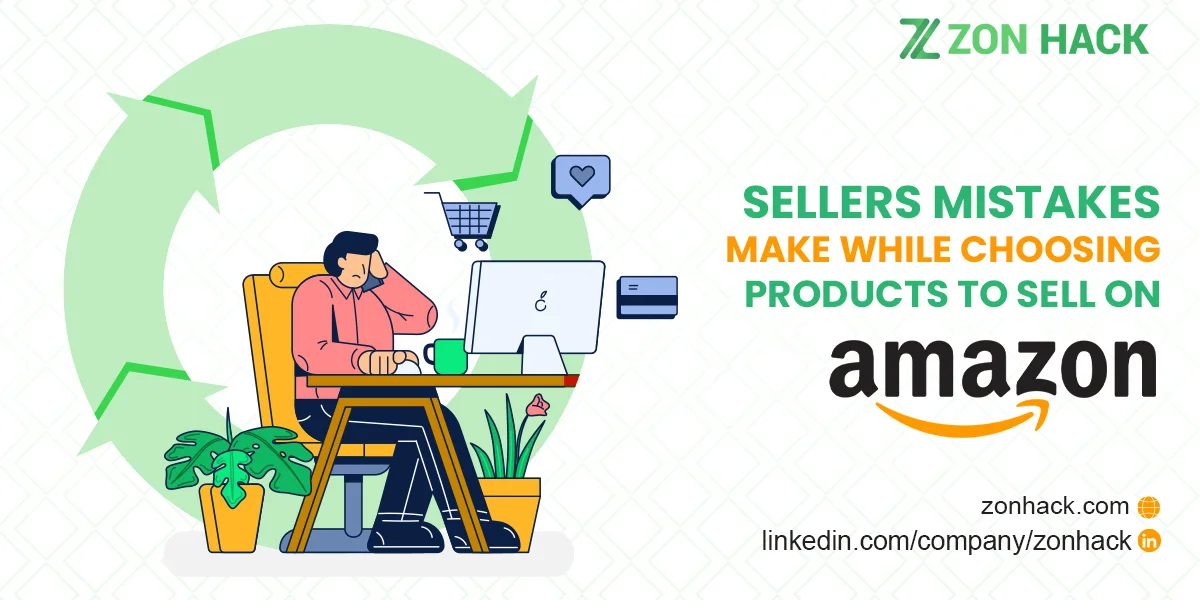The selling outlines and policies of Amazon are typically clear and straightforward. The marketplace has created a selling and buying atmosphere that helps sellers to avoid mistakes as much as possible. However, rather unfortunately, many sellers, especially beginners, make a few of these mistakes even with knowing.
This article explores the top mistakes that Amazon sellers make, especially either when setting up their accounts, selling their products, or handling their Amazon orders.
Without much ado, let’s get into it!
5 Common Mistakes Amazon Sellers Make
1. Using research tools to choose your products
Of the challenges that most people experience when starting to sell on Amazon is choosing the right product to sell, particularly how to choose a less competitive product with a good sales rank and profit margin.
While we have comprehensively explained how to choose the right product to sell on Amazon in this article, you should know that if you are doing the same thing, other sellers are doing, you will most likely get the same result.
A common trend amongst sellers that they “do not” know is wrong is using the same research tools that other sellers are using. This is logical; using the same research tool, the same filter, and methodology to choose your product technically makes you sell products in an already saturated niche. And if such niche isn’t flooded now, remember you aren’t the only one using the tool; hence, in a few months, such niche will most likely become oversaturated.
At Zon Hack, we have seen sellers complain about this repeatedly. And it is unfortunate that most beginner sellers still fall into this web.
However, this doesn’t entirely translate that research tools aren’t efficient. Instead, basing your research for the best sellable product on Amazon on these tools is one of the most significant errors you can commit as a seller.
Do not hesitate to discuss with the expert at Zon Hack the best practices on how to identify the best product ideas to sell on Amazon.
2. Selling the same products as others.
As an Amazon seller, you should always build strategies on how to gain an edge over your competitors. How is this possible?
We see many sellers simply choosing a sellable product on Amazon and start their private label business on the marketplace. This is wrong! Endeavour you improve your products before putting them out for sale. The improvements you make on these products suffice as your unique selling point (USP), which gives you the competitive edge that makes you stay relevant in the market.
Basically, to position yourself in the face of potential customers, making them choose you over your competitors, you should consider improving your product in the following category:
- Taste: create a unique taste for your product. And most importantly, make buyers see reasons to choose your taste over “others.” Because, undoubtedly, other informed sellers, just like you, are working assiduously to improve their products’ taste too.
- Customer service: It is no longer news that buyers love to be treated like kings and will most likely continue their patronage at places where their desires are met. Even if you have a great and unique product, poor customer service might make it extremely difficult for you to scale your business.
- Value: Offer your potential customers real value for their money!
While these categories may appear somewhat relative, depending on the niche, you are into. Nonetheless, you should familiarize yourself with them to avoid future mistakes. Other categories where improvement is needed include convenience and environment.
At Zon Hack, we strongly believe this is a winning formula to scale your Amazon business. Technically, if you pick the same products everyone is selling to sell, how exactly do you want potential customers to choose yours over others if you have nothing that stands you out? Hence, differentiating your product from your competitors’ is consequential to making more sales on Amazon.
3. Delivering a “below par” product
It is horrible to invest all of your efforts in setting up your Amazon account, sourcing products, setting a perfect pricing system, only to realize you are offering an “average” product for sale. Honestly, your chances of scaling your business with such a product are very slim.
The poorer a product is, the higher its bad reviews (if it makes sales), and the worse your reputation becomes on the marketplace. Therefore, while finding the best product to sell on Amazon, ensure you consider the quality of the product you choose and source from your supplier. Ensure you select products that can consistently provide at least 4.5-star ratings for you! This builds your business’ reputation and makes long-term sales possible for you.
It is pretty difficult for your competitors to knock you off the trends list if your product is highly rated, compared to if your profile is only filled with 3.0 and 4.0 stars. The quality and quantity of reviews your product receive from customers can either break or make your business.
4. Choosing an over-saturated market
Most sellers make the mistake of not conducting proper Amazon product research before they start selling on the marketplace. Instead, they “randomly” choose a niche, select products they “feel” are selling and good for their business, and just start selling. Unfortunately, this, almost always, doesn’t work out well. And this is because nearly every niche comes with already established competitors. Hence, it is typically difficult and challenging to go head-to-head with these sellers, especially when you are just starting out. The best solution is to go for niches with less already-established sellers, i.e., markets that aren’t “saturated.”
For instance, it is unwise for you as a new Amazon seller to choose to sell Men’s Tees with over 200,000 products. The competition and saturation in this market will undoubtedly choke your business.
5. Failure to vet supplier
Honestly, you can’t totally trust your supplier. Hence, you need to collaborate with those with a proven track record of excellent service delivery. Ensure you analyze the performance history of a supplier to ensure their trustworthiness before choosing to work with such a supplier. You may also further your research by monitoring the suppliers of your competitors.
Failure to vet your supplier may result in loss of money, especially from opportunity costs, overcharges, and others. It may ultimately lead to the collapse of your business!
Other Mistakes Amazon Sellers Make
1. Overstocking
Of course, you may feel the need to stock your inventory with more products, especially when such products are highly demanded. Some sellers also consider adding extra stocks in their inventory to enjoy a discount when buying from their supplier.
While this appears like a great idea, overstocking your inventory (excessive ordering of products) may cost you a lot of money. The loss of money in this regard cut across several aspects—first, the storage fees. The storage fees are fees sellers pay Amazon to store their products. If you aren’t selling as fast as you have predicted, you might be losing your revenues to the payment of storage fees. You can read more about Amazon seller fees HERE. (please, add a hyperlink to the post “how to calculate Amazon profit margin and costs).
Another way overstocking causes sellers to lose money is the cost and challenges experienced when eventually trying to get rid of the excess items. Liquidation most times doesn’t completely refund full investments. And if you want to return the inventory to yourself after sending them to Amazon fulfilment centres, you may need to pay Amazon up to $0.5 per unit.
So, basically, it is better to have limited inventory but a trusted supplier who can always be on your beck and call whenever you run out of stock.
2. Using wrong keywords, images, and titles.
This is another mistake that many Amazon sellers make, thanks to their inexperience in ranking their listings on Amazon. Zon Hack helps sellers to choose the right keywords for their listings, titles, and product images.
Similarly, you also need to stay up-to-date with these ranking elements because of Amazon limits and restrictions that are routinely rolled out. Exceeding any of these limits may automatically make your listing inactive. Below are some Amazon limits currently being implemented:
- The 100-character limit for essential product features, up to 500 characters per listing.
- The 249-byte limit for backend keywords.
- The 80-character limit for European third-party sellers’ title.
- 50-character product title limit for FBA listings.
Similarly, Amazon has specific restrictions that sellers must be aware of; otherwise, such a seller is risking the inactivity of their listing or ultimately suspend the listing. These restrictions include:
- Do not use ALL CAPITALS text.
- Symbols aren’t allowed.
- Do not include URLs or HTML code in your titles, descriptions, and images.
- Promotional information is prohibited. Avoid statements such as “x% off,” “Free,” “Lowest Price,” etc.
3. Lack of great customer service
Customer service is an essential part of all businesses. And this also applies to the Amazon marketplace. Generally, customers prefer shopping in places where they will enjoy excellent customer service, sometimes without considering the price. To scale a business, you must be intentional with how you attend to your customers.
Thankfully, if you use Amazon FBA, you do not need to worry about customer service as Amazon handles the entire process for you. However, if you fulfil your orders by yourself, you need to stay prepared to address all your customers’ issues, requests, and complaints, efficiently and swiftly.
Failure to address your customers’ issues as fast as possible may cause you to lose them to your close competitors with a better customer experience!
4. Overcharging for shipping
Buyers on Amazon general prefer free shipping. So, when you overcharge for shipping, you may be costing your feedback; such customers won’t hesitate to register their displeasure when Amazon asks them for feedback.
Hence, if your shipping rates are slightly more than normal, you can keep the price at the standard shipping rates and consequently increase your product’s cost to cater to shipping. However, you need to be cautious while doing this because you may end up pushing your customers way because of high product prices. Therefore, you need to strike a balance between a perfect price point and a standard shipping fee.
5. Delayed shipping
Late shipping is also a part of subpar customer service. While it is understandable that the supply chain of Amazon sellers can be quite complex, you still need to narrow it down. Dropshipping is the standard shipping practice on Amazon. Some persons also outsource their storage to fulfilment centres and specialized warehouses. Basically, once you can comply with Amazon’s invoicing requirements and general guidelines, you should be able to sell on Amazon without having to store all your products there. These requirements depend mainly on product categories, venue, and selling plan.
Albeit, what matters is that you deliver your products to customers as fast as possible. You can save yourself the stress of “too fast” deliveries by mentioning longer delivery times in your shipping policy. Let your soon-to-be customers know your shipping period takes more than two (2) working days.
6. Poor optimization of listing
I bet you won’t enjoy shopping in a store where you find it hard to locate what you are looking for. You will most likely turn around and exit such a store. The same applies to your Amazon product listings!
Most sellers, especially newcomers, make this mistake: they do not regard their product listing as a storefront, an advertisement of your product. Hence, the product listing of such sellers often misses the needed perfect touch.
Hence, ensure your product listing is as perfectly optimized as possible, including expert product images, detailed descriptions, effective and compelling titles, and competitive pricing.
Are you unsure of how to create and optimize your listing? Do not hesitate to contact the experts at Zon Hack for professional product listing optimization services.
Conclusion
Many Amazon sellers make several mistakes on the marketplace, thanks to Amazon’s plenty of guidelines, policies, and requirements to sell on their space. Nonetheless, being aware of these mistakes is the first big step to avoiding them. The commonest mistakes that sellers make while choosing a product to sell on Amazon, plus the solutions discussed in this article, will help you get over them as quickly as possible.




